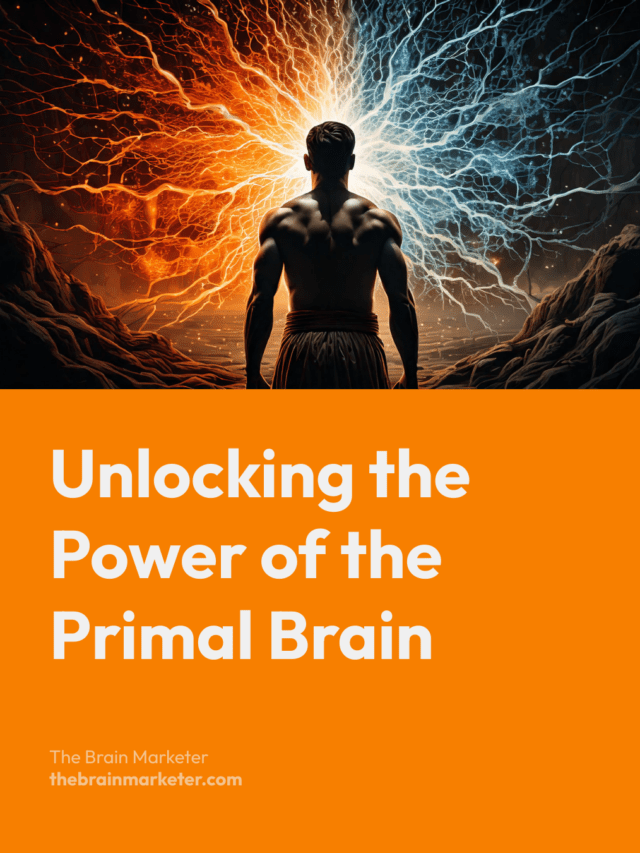Did you know that the decisions we make as consumers are deeply influenced by our primal brain? This part of our brain, often called the “all or nothing brain” by neuromarketing expert Patrick Renvoisé, plays a crucial role in ensuring our survival. But what does that have to do with marketing? A lot, as it turns out.
Key Takeaways
- The primal brain is instinctive, emotional, and fast-reacting.
- Marketing that appeals to safety, contrast, and simplicity resonates best.
- Visuals and emotions drive faster decisions than logic.
- Egocentric messaging (“what’s in it for me”) increases impact.
- Begin and end your message with power—these moments are best remembered.
🎙️ Unpack the Topic with this Podcast
What is the Primal Brain?
The primal brain, also known as the reptilian brain, is the most ancient part of our brain and governs our instinctive and survival-based behaviors. It’s egocentric, always seeking safety and comfort, and reacts quickly to external stimuli. This means that marketers who understand how to engage the primal brain can trigger more immediate, emotional responses from consumers—ultimately driving purchasing decisions.
The primal brain is sensitive to a few key stimuli. Let’s break them down.
1. Egocentrism: It’s All About Me
The primal brain is self-centered, constantly scanning the environment to ensure survival. When a situation appears unsafe or uncomfortable, we react instantly. For instance, we instinctively avoid sitting next to someone who seems intoxicated on public transport. In marketing, this egocentrism is key—messages should appeal directly to the consumer’s needs, safety, or well-being. Ask yourself: “How can my product make the consumer’s life better right now?”
Example: Amazon’s “Buy Now” button responds perfectly to this instinct—it creates a sense of speed and control that speaks directly to individual gain.
Application Tip: Use language that speaks directly to the consumer. Phrases like “You deserve better” or “This will make your life easier” tap into this egocentric nature.
2. Sensitivity to Contrast
The primal brain responds strongly to contrasts—before/after, risky/safe, with/without. That’s why transformation images (like those often used in TV shopping shows) are so effective. These contrasts create a clear narrative of improvement or risk avoidance without requiring cognitive effort.
Example: ProActiv skincare commercials often show dramatic before-and-after shots that highlight results. These visuals are processed instinctively and quickly by the primal brain.
Application Tip: Highlight the difference your product makes, whether it’s safety, comfort, or performance. “Before and after” photos or stories are particularly compelling.
3. Concrete and Tangible Information
The primal brain thrives on tangible, familiar, and relatable information. Abstract or complex ideas tend to confuse it. This is why marketing campaigns that use clear, simple messages are more successful.
Application Tip: Keep your messages simple, straightforward, and easy to visualize. Whether it’s a familiar object or a recognizable situation, grounding your communication in the concrete will resonate more effectively.
4. Memory of Beginnings and Endings
The primal brain is especially good at remembering the beginning and end of an experience. This is crucial for marketers aiming to make a lasting impression.
Application Tip: Start your campaigns with a strong hook and end them with a memorable call to action. First impressions matter, but so do final takeaways—make sure your consumer walks away with a clear understanding of the value you offer.
5. Visual Impact
Vision is one of the primal brain’s strongest senses. The optic nerve transmits 25 times more information than the auditory nerve, making visual content a powerful tool in grabbing attention. Studies show you have just 3 seconds to capture someone’s attention with a visual.
Example: Apple’s product pages use minimal text and striking product images against white backgrounds. This draws immediate attention and reinforces brand clarity.
Application Tip: Use bold, eye-catching visuals to stop scrolling or attract attention. Focus on simplicity—visuals should convey a clear message in seconds. Think of the “KISS” principle: Keep It Short and Simple.
6. Emotional Response
The primal brain reacts strongly to emotional stimuli. Emotions don’t just influence how we process information—they also determine what we remember. For example, advertisements for chocolate often focus on the pleasure associated with taste, triggering an emotional craving that can lead to an impulse purchase.
Application Tip: Leverage emotions in your marketing to create connections with your audience. Whether it’s joy, nostalgia, or even fear, emotional storytelling can be a powerful motivator.
Conclusion: How to Harness the Primal Brain in Your Marketing
Understanding how the primal brain works allows marketers to craft messages that stand out in a sea of advertising noise. By appealing to basic instincts like safety, comfort, and survival—and using contrast, visuals, and emotions—you can create campaigns that speak directly to the core of what drives consumer behavior.
In a world where consumers are bombarded with thousands of marketing messages every day, your goal should be to cut through the noise by connecting with the part of the brain that makes decisions—fast. Remember: the primal brain is all about survival. If you can show how your product or service helps your customers thrive, you’re on your way to success.
Sources
- Renvoisé, P. & Morin, C. (2007). Neuromarketing: Understanding the Buy Buttons in Your Customer’s Brain. Thomas Nelson.
- Damasio, A. (1994). Descartes’ Error: Emotion, Reason, and the Human Brain.
- Huberman, A. (2023). The Science of Vision and Attention.

Vincent Heimann is a marketing project manager and neuromarketing enthusiast. He founded The Brain Marketer to bridge neuroscience and marketing through accessible, science-based content. With over 10 years of experience in digital strategy, UX/UI and communication, he shares practical insights to help brands connect with the human brain — ethically and effectively

